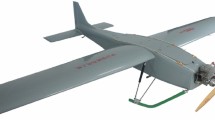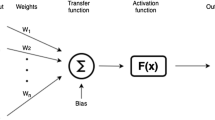Abstract
This paper describes a process of designing a thrust control loop for an electric-powered fixed-wing unmanned aerial vehicle equipped with a propeller and a motor. In particular, the modeling method of the thrust system for thrust control is described in detail and the propeller thrust and torque force are modeled using blade element theory. A relation between current and torque of the motor is obtained using an experimental setup. Another relation between current, voltage and angular velocity is also obtained. The electric motor and the propeller dynamics are combined to model the thrust dynamics. The associated trim and linearization equations are derived. Then, the thrust dynamics are coupled with the flight dynamics to allow a proper design for the thrust loop in the flight control. The proposed method is validated by an application to a testbed UAV through simulations and flight test.
















Similar content being viewed by others
Abbreviations
- \(\alpha \) :
-
Angle of attack [rad]
- \(\beta \) :
-
Propeller twist angle [rad]
- \(D_\mathrm{prop} \) :
-
Propeller diameter [m]
- \(\mathrm{{d}}L\) :
-
Propeller elemental lift [N]
- \(\mathrm{{d}}D\) :
-
Propeller elemental drag [N]
- i :
-
Current [A]
- \(i_0 \) :
-
No-load current [A]
- \(I_\mathrm{rotor} \) :
-
Rotor inertia
- \(I_\mathrm{prop} \) :
-
Propeller inertia
- J :
-
Advance ratio [-]
- \(K_V \) :
-
Velocity constant [(rad/s)/V]
- \(K_\mathrm{bemf} \) :
-
Back electromotive force constant [V/(rad/s)]
- \(K_\mathrm{Q} \) :
-
Torque constant [N m/A]
- \(k_\mathrm{T} \) :
-
Thrust coefficient [-]
- \(k_\mathrm{Q} \) :
-
Torque coefficient [-]
- \(a_\mathrm{T} \) :
-
Second order coefficient of approximated thrust coefficient
- \(b_\mathrm{T} \) :
-
First order coefficient of approximated thrust coefficient
- \(c_\mathrm{T} \) :
-
Zero order coefficient of approximated thrust coefficient
- \(a_\mathrm{Q} \) :
-
Second order coefficient of approximated torque coefficient
- \(b_\mathrm{Q} \) :
-
First order coefficient of approximated torque coefficient
- \(c_\mathrm{Q} \) :
-
Zero order coefficient of approximated torque coefficient
- L :
-
Inductance
- n :
-
Revolution per second [RPS]
- P :
-
Power
- \(Q_\mathrm{motor} \) :
-
Motor torque [N m]
- \(Q_\mathrm{prop} \) :
-
Propeller torque [N m]
- \(R_\mathrm{motor} \) :
-
Estimated motor resistance [Ohm]
- \(R_\Omega \) :
-
Measured motor resistance [Ohm]
- \(\rho \) :
-
Air density [\({m^{3}}/{kg}\) ]
- \(T_\mathrm{prop} \) :
-
Propeller thrust [N]
- \(\upsilon \) :
-
Viscous friction coefficient [N\(\cdot \)m/(rad/s)]
- \(V_\infty \) :
-
Forward air speed [m/s]
- \(\omega \) :
-
Angular velocity [rad/s]
- \(\omega _\mathrm{prop} \) :
-
Propeller angular velocity [rad/s]
- \(\beta _\mathrm{gear} \) :
-
Gear ratio
- \(V_{in} \) :
-
Input voltage [V]
- \(\omega _{co} \) :
-
Crossover frequency [rad/s]
- \(\mathrm{PM}\) :
-
Phase margin [\(^{\circ }\)]
- \(\mathrm{GM}\) :
-
Gain margin [-]
- \(\theta \) :
-
Pitch angle [rad]
References
Rubin R (2014) Drones : Quickly Navigating toward commercial Application, Starting With E-Commerce and Retail. Report, BI Intelligence, USA, Jan. 23
Hickey J (2015) Integrating UAS into the U.S Airspace System : ICAO RPAS Symposium, Montreal, Canada, 23–27 Mar 2015
Wang CJ, Sern Yung VC (2015) Unmanned aerial vehicle development trends & technology forecast. Report, DSTA Horizons, Singapore
Jonathan PH (2004) Aircraft stability and control. MIT Open courseware of Massachusetts Institute of Technology, Cambridge (fall)
Park Sanghyuk (2015) Guidance and control of flight vehicles. Graduate level lecture of Korea Aerospace University, Goyang
Yuan W, Jayakody H, Katupitiya J (2012) Dynamic modelling and analysis of a vectored thrust aerial vehicle. In: Proceedings of Australasian Conference on Robotics and Automation, Wellington, New Zealand, 3–5 Dec 2012
Lee Byung-Yoon, Yoo Dong-Wan, Tahk Min-jea (2013) Performance comparison of three different types of attitude control systems of the Quad-Roter UAV to perform flip maneuver. Int J Aeronaut Space Sci 14(1):58–66
Sharf I, Nahon M, Harmat A, Khan W, Michini M, Speal N, Trentini M, Tsadok T, Wang T (2014) Ground effect experiments and model validation with Draganflyer X8 Rotorcraft. In: 2014 International Conference on Unmanned Aircraft Systems. Orlando, USA, 27 – 30 May
Stančić I, Ljubičić A, Cecić M (2015) Identification of UAV engine parameters. Wseas Trans Syst Control 10:179–185
Grau JJ (2012) Testing bench design and tilting propeller system identification for the development and control of a thrust-vectoring hovercraft. Master thesis, South Dakota School of mines and Technology, USA
Podharadský M, Bone J, Coopmans C (2013) Battery model-based thrust controller for a small, low cost multirotor unmanned aerial vehicles. In : 2013 international Conference on Unmanned Aircraft Systems, Atlanta, USA, 28–31 May, 2013
Mathew S (2006) Wind energy fundamentals, resource analysis and economics. Springer, Berlin (ISBN-10 3-540-30905-5)
Brandt JB, Selig MS (2011) Propeller performance data at low Reynolds numbers. AIAA paper 2011-1255, January 2011
Kenjo TAK (1991) Electric motors and their controls. Oxford University Press, New York
Hanselman Duane(2003) Brushless permanent magnet motor design 2\(^{nd}\) edition. Writers’ Collective, Ohio (ISBN : 1-932133-63-1)
Jr Hendershot JR, Miller THE (1994) Design of Brushless permanent-magnet motors. Oxford university press, New York (ISBN : 1-881855-03-1)
Acknowledgements
This research was supported by Basic Science Research Program through the National Research Foundation of Korea (KRF) funded by the Ministry of Education (NRF-2015R1D1A1A01060574).
Author information
Authors and Affiliations
Corresponding author
Rights and permissions
About this article
Cite this article
Byun, H., Park, S. Thrust Control Loop Design for Electric-Powered UAV. JASS 19, 100–110 (2018). https://doi.org/10.1007/s42405-018-0003-9
Received:
Accepted:
Published:
Issue Date:
DOI: https://doi.org/10.1007/s42405-018-0003-9




